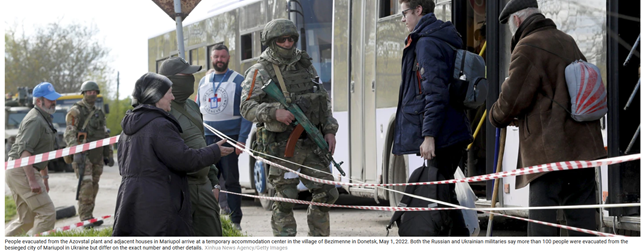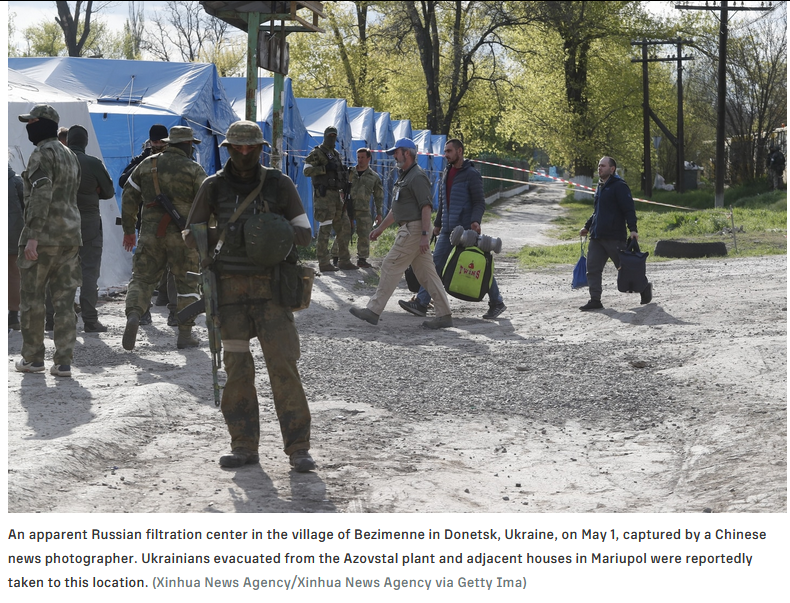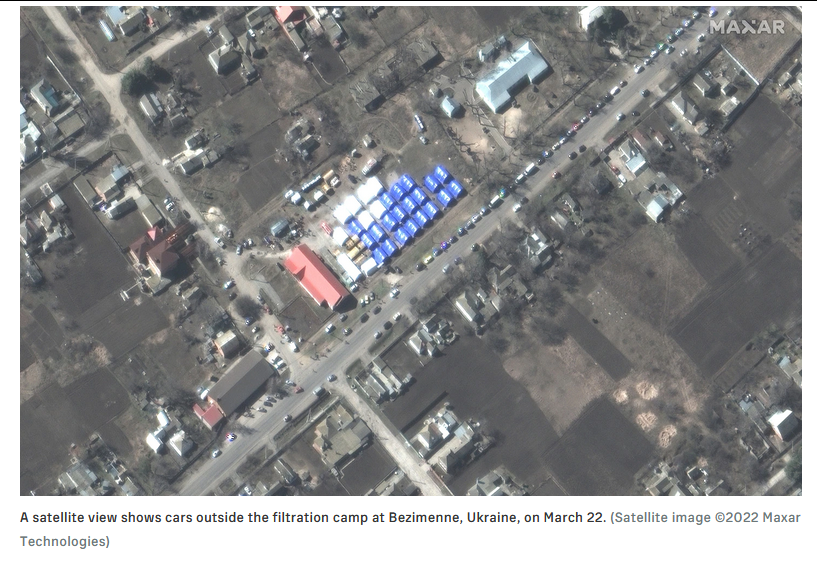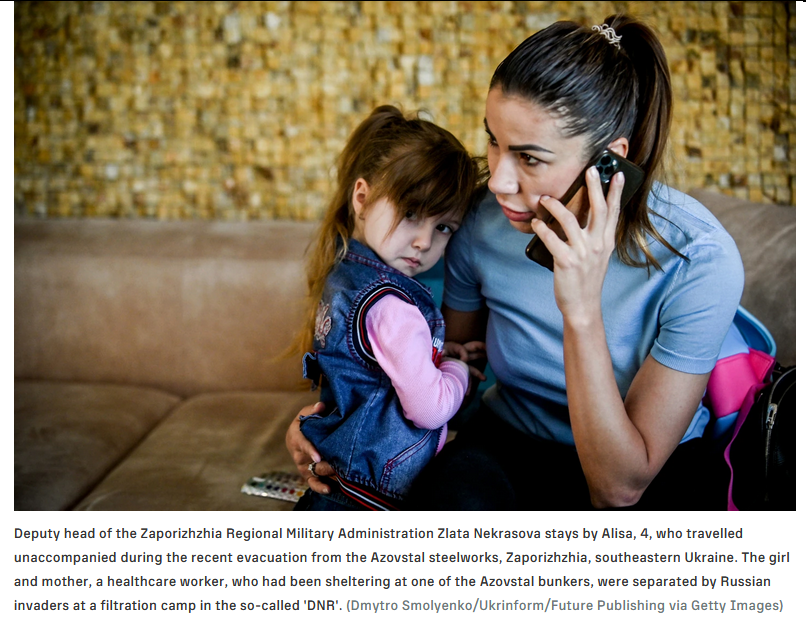
but differ on the exact number and other details.
Xinhua News Agency/Getty Images
The Organization for Security and Co-operation in Europe (OSCE) described Russia’s use of the filtration and deportation system as a war crime
Almost since the war began, Ukrainians have accused Russian forces of detaining civilians, interrogating them and in many cases forcing them not only from their homes but from their country.
Now, new details are emerging about the scope and scale of Russia’s use of “filtration camps,” makeshift detention centers Russia and proxy forces use to hold, interrogate and deport hundreds of thousands of Ukrainians. A growing number of experts and officials believe the camps are part of a larger, orchestrated campaign to erase Ukrainian nationality that amounts to genocide.
Russia has moved an estimated 1.5 million Ukrainians, including over 200,000 children, to Russia and Russian-controlled areas of Ukraine, according to both Russian and Ukrainian officials. Multiple reports show that Russian forces use an archipelago of filtration camps in Russian-controlled eastern Ukraine to hold and scrutinize many of them. Ukrainians who have passed through the camps have reported treatment ranging from humiliation to verbal abuse and physical torture. They say Russian forces and pro-Russian separatists in eastern Ukraine subjected them to strip searches, confiscated and searched their electronic devices, used electric shocks to torture them, and staged mock executions of detainees.
Russia’s troubling history of filtration camps
The filtration camps appear to serve purposes similar to Russian and Soviet camps in earlier conflicts, from World War II to the Chechen wars of the 1990s: to identify civilians who they believe can assimilate into Russian culture and Russian rule, and punish or remove those who won’t.
“Filtration camps are rooted in Soviet and Russian history,” said Khrystyna Holynska, a defense and policy researcher at the Rand Corporation. “It was a way to, first, get rid of those who could pose a threat to the regime by resisting it. And secondly, it is a way to spread fear and sow distrust among the rest to prevent them from even thinking about resisting.”
Some of those who pass the test of loyalty are freed; others have been kept in these camps in Russian-held territory or taken to Russia.
The growing number of accounts has led to widespread condemnation.
“Evidence is mounting that Russian authorities are detaining or disappearing thousands of Ukrainian civilians who do not pass ‘filtration,’” Secretary of State Antony Blinken said in a press statement.
Grid reviewed firsthand accounts from local news reports, Ukrainian and Russian government statements, international human rights reports, intelligence reports, satellite imagery and videos posted to social media to gain a better understanding of the truth on the ground. Much remains unknown about the camps’ operations or the fate of thousands of Ukrainians who have not been heard from since being taken to the camps.
Russia has moved an estimated 1.5 million Ukrainians, including over 200,000 children, to Russia and Russian-controlled areas of Ukraine, according to both Russian and Ukrainian officials. Multiple reports show that Russian forces use an archipelago of filtration camps in Russian-controlled eastern Ukraine to hold and scrutinize many of them. Ukrainians who have passed through the camps have reported treatment ranging from humiliation to verbal abuse and physical torture. They say Russian forces and pro-Russian separatists in eastern Ukraine subjected them to strip searches, confiscated and searched their electronic devices, used electric shocks to torture them, and staged mock executions of detainees.
Russia’s troubling history of filtration camps
The filtration camps appear to serve purposes similar to Russian and Soviet camps in earlier conflicts, from World War II to the Chechen wars of the 1990s: to identify civilians who they believe can assimilate into Russian culture and Russian rule, and punish or remove those who won’t.
“Filtration camps are rooted in Soviet and Russian history,” said Khrystyna Holynska, a defense and policy researcher at the Rand Corporation. “It was a way to, first, get rid of those who could pose a threat to the regime by resisting it. And secondly, it is a way to spread fear and sow distrust among the rest to prevent them from even thinking about resisting.”
Some of those who pass the test of loyalty are freed; others have been kept in these camps in Russian-held territory or taken to Russia.
The growing number of accounts has led to widespread condemnation.
“Evidence is mounting that Russian authorities are detaining or disappearing thousands of Ukrainian civilians who do not pass ‘filtration,’” Secretary of State Antony Blinken said in a press statement.


The Organization for Security and Co-operation in Europe (OSCE) described Russia’s use of the filtration and deportation system as a war crime
The Organization for Security and Co-operation in Europe (OSCE) described Russia’s use of the filtration and deportation system as a war crime: “Mass forcible transfers of civilians during a conflict to the territory of the occupying party are prohibited under the 1949 Geneva Conventions.” The OSCE said the practice was “somewhat reminiscent of the extraordinary renditions used in the so-called war against terrorism,” referring to the U.S. mistreatment of detainees after 9/11. For historians and others with long memories, the system has invited more direct comparison to the infamous Gulag prison system created by the Soviet Union during the rule of Joseph Stalin.
“The ‘filtration’ camp language invokes loaded Russian words tracing back to World War II-era camps,” said Kristina Hook, an assistant professor of conflict management at Kennesaw State University. “Today, these sites are operating in Russian-occupied territories of Ukraine and are believed to be black holes of human rights abuses.” Hook believes the filtration camps are part of a broader genocidal effort by Russia in Ukraine to erase Ukrainian national identity.
The numbers
Since Russia’s invasion of Ukraine, both sides have inflated statistics and exaggerated claims to suit their narratives. But in terms of the sheer number of Ukrainians who have been “forcibly deported” (according to Ukraine) or “emigrated” (according to Russia), there is some agreement. In May, a Russian official acknowledged that “1,426,979 people, of which 238,329 are children,” had been “evacuated from dangerous areas of the republics of Donbas and Ukraine to the territory of the Russian Federation.” It’s broadly assumed that the Russians delivered most civilian deportees to filtration camps.
Lyudmila Denisova, the former Ukrainian Parliament commissioner for human rights, reported that Russia had deported 1,377,925 Ukrainians, 232,480 of whom were children, as of May 21. That number has since grown to over 1,700,000 Ukrainians as of June, according to the OSCE.
This accounts for those who have likely been through the camps and “released.” Questions remain about those that the Russian government decides to hold.
Stories from the camps
After months of mostly murky, secondhand accounts, multiple stories from the “filtration camps” have begun to emerge.
“There were 36 of us in a cell for six people,” Yevgeny Malyarchuk, a businessman from Mariupol, told Current Time TV, a Prague-based, Russian-language TV station operated by Radio Free Europe. “At the same time, not everyone could lie down, even sit down. Slept in several shifts. It was very hard.”
Malyarchuk said he was attempting to deliver aid to people during the Russian siege of Mariupol when he was captured and brought to a filtration camp. He said he was held for 100 days in a former penal colony in the Ukrainian town of Yelenovka, outside of Donetsk.
Other firsthand accounts describe humiliating interrogations that include being forced to strip naked so that Russians could check for tattoos that might then be taken as “evidence” for opposition to Russia or support for the Ukrainian resistance.
Russian forces and pro-Russian officials in eastern Ukraine have also searched detainees’ mobile electronic devices for anti-Russian sentiment in the form of pro-Ukrainian internet pages and social media groups, former detainees told Politico. A Ukrainian woman told CNN of her experience at a filtration camp: “Once you surrender your phone, they check you in for the first phase of the process. They photograph you from all angles, for facial recognition I suspect. Next you give them your fingerprints and, strangely, palm prints. I don’t know why.” She added that the Russians entered her details in a database. “The next stage, you go in for questioning.”
According to the Ukrainian non-governmental organization Crimea SOS, “In some instances, people are forced to sign testimonies that they were interrogated and tortured by Ukrainian forces.”
A group of Ukrainian aid workers captured by Russian forces and brought to the same former prison colony outside of Donetsk described the conditions there to Mediazona, an independent Russian publication.
The group, whose members were released after several weeks, reported beatings, sadistic prison guards, and minimal food or water at their filtration camp. They said the complex held both prisoners of war and civilians. They described the leadership of the prison camp by name and recalled details of their cruelty.
“Evsyukov Sergey Vladimirovich, in my personal opinion, is one of the worst executioners who manages this entire camp,” said Stanislav Glukshov, a transportation worker with the group. “[Vladimirovich] repeatedly told us that we would stay there for at least ten years, that our children, our families would be told that we flew into space, or that we are military pilots who died.”
“We will detain all bandits and fascists”
“We will detain all bandits and fascists”
A review of news reports and government analyses indicates Russia and allied separatist groups have created filtration camps at police stations, decommissioned prisons and tent encampments. Most are in the People’s Republic of Luhansk and People’s Republic of Donetsk, the regions in eastern Ukraine that have been controlled by Russia-backed separatists since before Russian President Vladimir Putin’s February invasion.
The United States last month released a declassified intelligence report on Russia’s “Systemic Filtration Operations,” which detailed much of what American analysts have gleaned about the program. The report, which a Defense Department official called “chilling,” identifies 18 camps.
Last week, Poland’s intelligence service publicized the coordinates of five locations in Ukraine it believed housed filtration camps. Grid reviewed Maxar satellite imagery of the locations, which showed nondescript buildings, a tent city, and lines of buses and other vehicles. Russia has not denied the existence of filtration camps — but challenged the suggestion that they are punitive in nature. The Russian Embassy in Washington, D.C., framed the camps as part of an effort to foil saboteurs.
“We emphasize: in this case, we are talking about checkpoints for civilians leaving the zone of active hostilities,” the embassy said. “In order to avoid sabotage operations by the Ukrainian national battalions, servicemen of the [Russian Federation] Armed Forces carefully inspect vehicles heading to safe regions.
“We will detain all bandits and fascists. The Russian military does not create any barriers for the civilian population, but helps [them] to stay alive, provides them with food and medicine.”
The embassy has since referred to reports about the camps as “low-quality Western misinformation.” It did not respond to inquiries from Grid for this story.
Western analysts and diplomats don’t buy the Russian explanations. The camps are “designed to weed out those who cannot be forcibly Russified, that is, those who will not accept the Kremlin’s propagandistic claims that Ukrainian national identity is an artificial construct,” Kennesaw State’s Hook wrote in Foreign Affairs magazine last week. Hook and others believe the camps are one aspect of a broader Russian effort to commit genocide against Ukrainians.
Beyond the camps, mystery and danger
Detainees whom the Russians believe have connections to the Ukrainian military or security services appear to receive the harshest treatment, most likely including being sent to prisons in eastern Ukraine or Russia. In their July report, U.S. officials cautioned that “little is known about their fates.”
Ukrainians without apparent ties to the military, but whom the Russians consider of possible concern — perhaps for their pro-Ukrainian sentiment or resistance to Russian occupation — appear to be leading candidates for forcible deportation to Russia.
Those detainees who are not considered a threat receive official documentation and are permitted to leave the camps. At that point they face a choice: remain in the Russian-occupied areas of Ukraine or be forcibly transported into the Russian interior.
Meanwhile, it appears that Russia has moved many Ukrainian civilians from the camps to far-flung spots in Russia.
One woman told CNN that at the Russian border, those with no family or friends in Russia were being sent nearly 1,000 miles east, to the city of Vladimir. But other reports suggest Ukrainians have been sent on even longer journeys.
A May investigation by British outlet I News found 66 “former Soviet sanatoriums, children’s wilderness camps, hostels and orphanages,” often in extremely remote parts of Russia, were the final destinations for many Ukrainians who had passed through the filtration camps. The news site found a group of 300 people who had been sent to Vladivostok, the largest city in Russia’s far east, thousands of miles from Ukraine, after a seven-day train trip on the Trans-Siberian Express. Vladivostok is closer to Tokyo than to Moscow.While Ukrainians are free to leave such sites, the remoteness and lack of resources can effectively force them to remain, according to the I News investigation.
The fate of children
Human rights advocates believe Russians have separated Ukrainian children from their parents at the filtration camps and placed Ukrainian orphans with Russian families.
Michelle Bachelet, the high commissioner for human rights at the United Nations, told the Human Rights Council that her office is looking into allegations that children in orphanages had been taken to Russia. According to UNICEF, Ukraine had more than 91,000 children in orphanages before the Russian invasion.

BuzzFeed News reported that Russia is transporting Ukrainian children across the border, a violation of international law. The outlet recounted the harrowing story of a grandmother searching for her missing 3-year-old granddaughter and described Russians “evacuating” children from Ukrainian orphanages to Russia. Ukrainian children from orphanages are being adopted by Russian families, according to the report.
What we don’t know
Those who have studied the allegations about the filtration camp system are quick to point out that these are stories from the survivors — the people who have passed through the system and emerged to speak about the experience. Virtually everything we know about filtration camps is based on their accounts.
There are likely hundreds of thousands of other Ukrainians still held — either in the Russian-occupied regions of Ukraine or inside Russia itself. There are those in Russia who are technically “free to leave” but likely lacking any means to do so. And there are those children who have been taken to Russia.
“Most of the information on what is going on in these camps we get from the people who managed to ‘pass’ the filtration,” said Holynska at Rand. “They report on what they could observe or overhear. They talk about the inhumane conditions they had to endure until they were released.
“We have very limited information on those who are not released.”
Jason Paladino, Investigative Reporter,https://www.grid.news/story/global/2022/08/08/russian-filtration-camps-black-holes-of-human-rights-abuses-where-ukrainians-face-torture-and-loyalty-tests/




